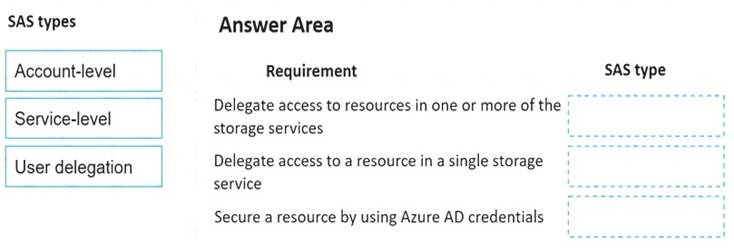- (Topic 8)
Note: This question is part of a series of questions that present the same scenario. Each question in the series contains a unique solution that might meet the stated goals. Some question sets might have more than one correct solution, while others might not have a correct solution.
After you answer a question in this section, you will NOT be able to return to it. As a result, these questions will not appear in the review screen.
You develop and deploy an Azure App Service API app to a Windows-hosted deployment slot named Development. You create additional deployment slots namedTestingand Production. You enable auto swap on the Production deployment slot.
You need to ensure that scripts run and resources are available before a swap operation occurs.
Solution: Disable auto swap. Update the app with a method named statuscheck to run the scripts. Re-enable auto swap and deploy the app to the Production slot.
Does the solution meet the goal?
Correct Answer:
B
Instead update the web.config file to include the applicationInitialization configuration element. Specify custom initialization actions to run the scripts.
Note: Some apps might require custom warm-up actions before the swap. The applicationInitialization configuration element in web.config lets you specify custom initialization actions. The swap operation waits for this custom warm-up to finish before swapping with the target slot. Here's a sample web.config fragment.
<system.webServer>
<applicationInitialization>
<add initializationPage="/" hostName="[app hostname]" />
<add initializationPage="/Home/About" hostName="[app hostname]" />
</applicationInitialization>
</system.webServer>
Reference:
https://docs.microsoft.com/en-us/azure/app-service/deploy-staging-slots#troubleshoot- swaps
DRAG DROP - (Topic 8)
You develop and deploy an Azure App Service ---- app. The web app accesses data in an Azure SQL database
You must update the web app to store frequently used data m a new Azure Cache for Redis Premium instance.
You need to implement the Azure Cache for Redis features.
Which feature should you implement? To answer, drag the appropriate feature to the correct requirements Each feature may be used once, more than once, or not at all You may need to ------------ between panes or scroll to view content.
NOTE Each correct selection is worth one point
Solution:
Does this meet the goal?
Correct Answer:
A
DRAG DROP - (Topic 8)
You have a web app named MainApp. You are developing a triggered App Service background task by using the WebJobs SDK. This task automatically invokes a function code whenever any new data is received in a queue.
You need to configure the services.
Which service should you use for each scenario? To answer, drag the appropriate services to the correct scenarios. Each service may be used once, more than once, or not at all. You may need to drag the split bar between panes or scroll to view content.
NOTE: Each correct selection is worth one point.
Solution:
Box 1: WebJobs
A WebJob is a simple way to set up a background job, which can process continuously or on a schedule. WebJobs differ from a cloud service as it gives you get less fine-grained control over your processing environment, making it a more true PaaS service.
Box 2: Flow
Does this meet the goal?
Correct Answer:
A
- (Topic 8)
You develop and deploy an Azure App Service web app to a production environment. You enable the Always On setting and the Application Insights site extensions. You deploy a code update and receive multiple failed requests and exceptions in the web app. You need to validate the performance and failure counts of the web app in near real time. Which Application Insights tool should you use?
Correct Answer:
D
- (Topic 8)
Note: This question is part of a series of questions that present the same scenario. Each question in the series contains a unique solution that might meet the stated goals. Some question sets might have more than one correct solution, while others might not have a correct solution.
After you answer a question in this section, you will NOT be able to return to it. As a result, these questions will not appear in the review screen.
You are developing an Azure solution to collect point-of-sale (POS) device data from 2,000 stores located throughout the world. A single device can produce 2 megabytes (MB) of data every 24 hours. Each store location has one to five devices that send data.
You must store the device data in Azure Blob storage. Device data must be correlated based on a device identifier. Additional stores are expected to open in the future.
You need to implement a solution to receive the device data.
Solution: Provision an Azure Service Bus. Configure a topic to receive the device data by using a correlation filter.
Does the solution meet the goal?
Correct Answer:
A
A message is raw data produced by a service to be consumed or stored elsewhere. The Service Bus is for high-value enterprise messaging, and is used for order processing and financial transactions.
Reference:
https://docs.microsoft.com/en-us/azure/event-grid/compare-messaging-services